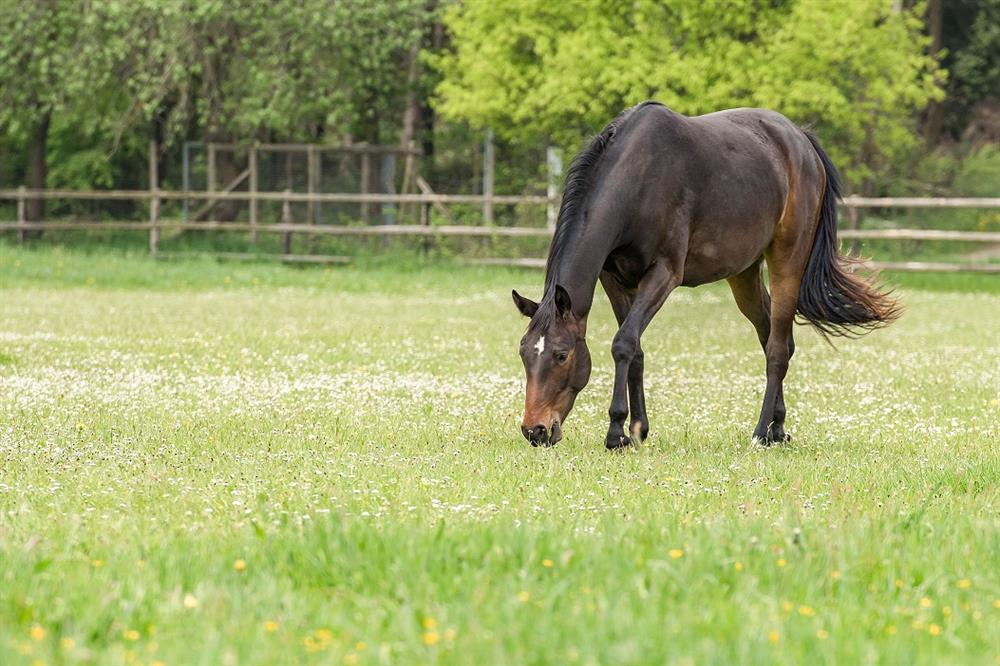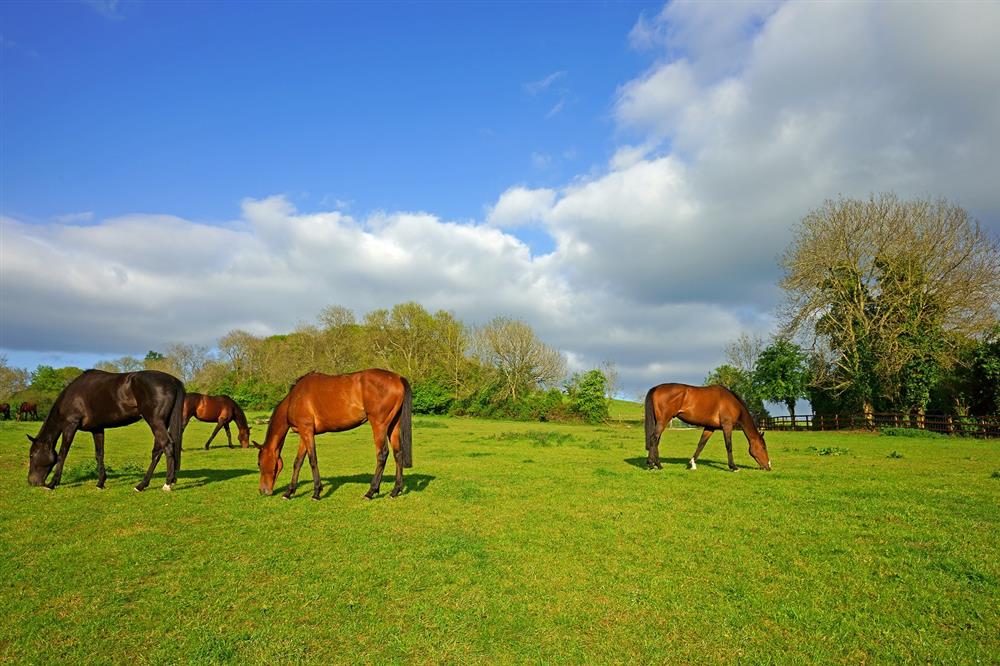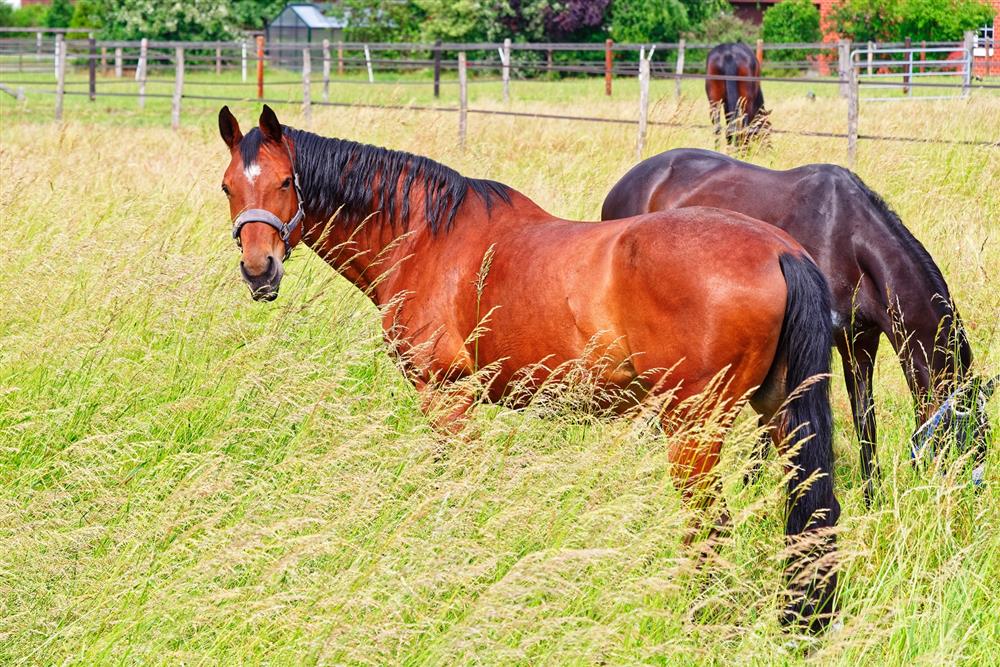Equine grazing behaviour
Horses are naturally selective grazers which means that they will not eat everything in their pasture. This is because compared to other ruminants they are not able to digest fibre as efficiently so will seek out younger herbage.
A horse will spend approximately 70% of daylight hours and 50% of night hours when at pasture grazing and covering up to 7 miles. This is equivalent to up to 17 hours a day! The rest of the time will consist of the horse walking, sleeping, drinking and socialising. However, horses with restricted grazing time will tend to eat more intensely. In addition, they prefer not to graze in areas where they have defecated or urinated.

Mature horses generally consume 2 – 2.5% of their body weight in dry matter (DM) of feed each day. A minimum of 8 to 10 hours grazing is needed to achieve a DM intake of about 1% of body weight. By providing less grazing or restricting your horse’s grazing time will mean that they require additional forage such as hay and hard feed in order to achieve the desired DM intake and nutrient requirements.
The suggested land requirement is about 1 to 1½ acres per horse however this may vary due to a number of factors including:
- The time of year
- Size and breed of the horse or pony
- Quality of the grazing and soil type
- How many animals are kept on the pasture
- The length of time the pasture is grazed (i.e. is the horse stabled sometimes or exercised)
- How well the pasture is managed and looked after
Which nutrients does grass provide?
Grass is high in digestible energy (DE), crude fibre (CF) and crude protein (CP) however the quality of your grazing will determine the nutrient value it provides for your horse. In general, grass provides an excellent source of vitamins and minerals which include calcium, phosphorus, vitamin E and selenium among others. In some cases, grass alone can provide your horse with its daily nutrient requirements but more often than not grazing must be accompanied with other nutrient sources such as hay, hard feed and/or vitamin and mineral supplements.
Good soil is the basis for growing good quality grass. The key nutrients for grass growth are Nitrogen, Phosphorus and Potassium with a soil pH of between 5-6.5.
Some people choose to fertilise their grass however not all grazing requires added fertiliser and unnecessary application, applying the wrong type or using it in excess can produce overly rich grass. This can cause laminitis, colic and obesity so only do this if it is necessary, then ensure you are using a slow releasing fertiliser that is suitable for horses.
Having your soil tested can be a great way to get a better idea of the quality of grass you are feeding.
Horses grazing on sandy soils become at risk of developing sand burdens. This is where it is very important to provide extra forage.

Grazing systems
There are different types of grazing systems that can be used to suit your horse or the amount/ quality of grazing available. These include:
Continuous – the simplest of systems, where the horse is able to graze unrestricted 24hrs per day, 7days a week regardless of the time of year. This encourages selective grazing and weed growth. Depending on the factors mentioned earlier regarding land requirements, this can mean that the grass does not get rested for long enough to be able to regrow, however continuous grazing can provide an easy and cheap option.
Limited turnout time - for example turning out during the day and bringing in at night. This can be suitable for fat or laminitic horses that require restricted grazing.
Rotational – this involves rotating one or more horses through a selection of smaller pastures throughout the year. The advantage of this is that the rest periods will allow the grass to regrow and reduces the risk of overgrazing of the most palatable grass.
Partial-season – some people may only turn their horses out over the spring and summer months and keep their horses stabled throughout autumn and winter or visa verse. This may be due to adverse weather conditions or limited grazing.
Strip grazing – this is where the boundary of the paddock is moved little and often in order to give the horse a fresh strip of grass. This can be used to reduce selective and overgrazing on a larger paddock and is a good way to manage your horses’ weight or control grass intake. This method also allows larger amounts of the paddock to rest.
Track – using a track system is now becoming more and more popular as it encourages movement and mimics the environment and feeding habits of feral horses. Track systems consist of a paddock divided into track around the edge of the field and can incorporate different terrains to help condition feet and obstacles to encourage the use of different muscles. Hay is often supplemented around the track.
Looking after your pastures
In order to optimise your available grazing and provide the best care for your horse, there are a few management practices that should be considered:
- Weed and poisonous plant control
- Preventing overgrazing
- Topping/mowing
- Safe perimeter fencing
- Providing of shelter
- Providing a clean water source
- Regular poo picking
If you are at all concerned about whether your horse requires any additional nutritional supplementation, then contact our nutritionist via [email protected].


